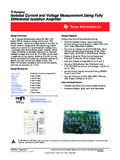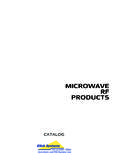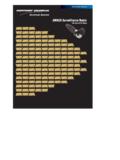Transcription of Miniature solutions for voltage isolation - TI.com
1 13 analog Applications JournalMiniature solutions for voltage isolationThe hot growth in distributed-power architecture hasfueled the development of Miniature low-power (<2-W)DC/DC converters. As their name implies, these devicesminimize the impact of the converter onboard space. Theyprovide point-of-use isolated power conversion for analogcircuitry in industrial applications and safety-critical appli-cations such as telecommunications and medical , Miniature DC/DC converters benefit designerswho need galvanically isolated output power or noisereduction in analog most modern noise-sensitive circuitry, system designersoften have a small number of components that requiretotal isolation from their input power supply.
2 It is neces-sary to isolate the load and noise presented to the localpower-supply rails from the main-supply rails of the entiresystem. Mixed-signal integrated circuit (IC) design, forexample, frequently leads to nonfunctional devicesbecause of noise problems. Large amounts of digital noisecombined with sensitive analog circuitry often results ininterference DC/DC converters with galvanic isolation offervery low output noise and high accuracy. Galvanic isolationhelps to reduce system noise by providing a floatingground on the secondary side of the isolation can then be used to provide asimple, isolated-output power source; or, it could be usedto generate different voltage rails, dual-polarity rails,and/or nonstandard voltages.
3 Also, as a noise reductiontechnique in analog circuitry, the isolation barrier preventsnoise from the digital ground bus from affecting the sensi-tive analog standard brick-type converter is not well suited forthis requirement. In addition to its higher cost, the brick soutput power is overkill for applications requiring <2 s more, the installed size of a brick is often require miniaturization to save valuable boardreal estate. Because they are significantly smaller thaneven the new sixteenth-brick format ( in2vs. in2), Miniature DC/DC converters are particularly suited to gen-erating onboard voltages in space-constrained why not roll your own DC/DC power supply?
4 Discretecomponent onboard converter designs are a low-cost alterna-tive to bricks and off-the-shelf Miniature DC/DC , fewer designers are developing discrete designsbecause of their disadvantages. Extra functionality,such asdevice protection and module-to-module synchronization,are difficult to implement; reliability is often poor; andachieving a small-sized power supply is difficult. In addi-tion, many designers of higher-level products of whichthe DC/DC converters are only one component lack thetime to become expert enough in converter design tobuild their own devices. As a result of these challenges,more and more designers are specifying Miniature DC/DCconverters for their applications.
5 The converters offer significantly lower risk, much faster time to market, anddevelopment-cost their advantages over bricks and discrete designs, Miniature DC/DC converters also provide a compact-sizedpower solution for point-of-load (POL) power converters enable designers to overcome the chal-lenges caused by the high peak-current demands and low-noise margins of the latest high-performance semicon-ductor devices. The converters can be placed close totheir loads. This minimizes losses caused by voltage drops,helps overcome noise sensitivity and EMI emission issues,and ensures tight regulation under dynamic load s available? Miniature DC/DC converters offered by C&D Technologies,Texas Instruments, Wall Industries, and others benefitdesigners who require isolation and output current in the20- to 500-mA range.
6 The converters are available with 5-, 12-, 15-, or 24-V inputs. Single-output converters areavailable with voltages from to 24 VDC. Dual-outputconverters with voltages from to 24 VDC are DC/DC converters offer regulated or unregulatedoutputs with input-to-output isolation ratings of 1000,1500, or 3000 VDC. Operating temperature extends from 40 C to +100 C. Due to their high switching frequencies(up to 400 MHz), the converters deliver efficiencies of upto 85%.Built-in featuresFor system designers seeking to implement miniatureDC/DC converters, the devices offer various built-in featuresthat ease system integration and simplify design. Many ofthe available products incorporate thermal and short-circuitprotection and internal filtering.
7 Some of the more advancedconverters allow device-to-device synchronization. If anapplication uses more than one converter on a PC board,Texas Instruments IncorporatedPower ManagementBy Geoff Jones (Email: Manager3Q and Mixed-Signal ProductsTexas Instruments IncorporatedPower Management14 analog Applications JournalAnalog and Mixed-Signal 2005beat frequencies and other electrical interference can begenerated. DCP010512B and DCR010505 converters(Figure 1) overcome this problem with a built-in synchro-nization control that allows multiple converters to be syn-chronized to one another. The feature makes it easy fordesigners to synchronize up to eight devices by connectingthe SYNCIN pins together.)
8 This eliminates electrical inter-ference caused by variations in switching s DC/DC converter technologies continue to focuson higher densities and efficiencies as well as on smallerpackages. One of the more innovative converters is manu-factured with the same technology as standard IC packages,including dual-in-line (DIL) and small-outline (SO) styles+5 V+5 V 5 V+12 V+5 VNonisolatedI/O ModulesSupportOp Amp, ADC,DAC, MCU, ModulesSupportOp Amp, ADC,DAC, MCU, to30 VDC5-VPowerSupplyCreate +12-V/1-WOutput with1000-V IsolationCreate Isolated 5-V/1-W Outputfrom +5-V InputSYNCINSYNCINF igure 1. Self-synchronizing DC/DC converters indistributed-power applicationFigure 2.
9 Miniature isolated DC/DC converterin standard IC packageFigure 3. IC lead-frame(Figure 2). They use an IC lead-frame as the medium tointerconnect silicon devices and magnetic componentswithin the IC package (Figure 3). The result is an isolatedDC/DC converter that provides high reliability, excellentthermal management, small size, and compatibility withstandard board-assembly processes. The standard IC formatalso allows tape-and-reel assembly, which helps reducemanufacturing Instruments IncorporatedPower Management15 analog Applications Journal3Q and Mixed-Signal ProductsDifferent configurationsThe galvanic isolation of the output from a miniatureDC/DC converter allows nonstandard voltage rails to begenerated by connecting multiple converters in series.
10 Thisis accomplished by simply connecting the positive output ofone converterto the negative output of another. This con-figuration allows a wide variety of voltage variations to beproduced. The outputs on some dual-output converterscan also be connected in series to provide two times themagnitude of output voltage . Figure 4 shows a dual 15-Vconverter connected to provide a 30-V converters connected in parallel often providea suitable solution for cases where a single converter isunable to deliver the required output power. When parallelconnection is used, it is always a good design practice touse parallel converters of the same type. Figure 5 showstwo converters connected in voltage isolation in low-power applicationsMiniature DC/DC converters that provide input-to-outputisolation and low output power offer innovative solutionsfor high-density power-supply designs in a variety of appli-cations.
















